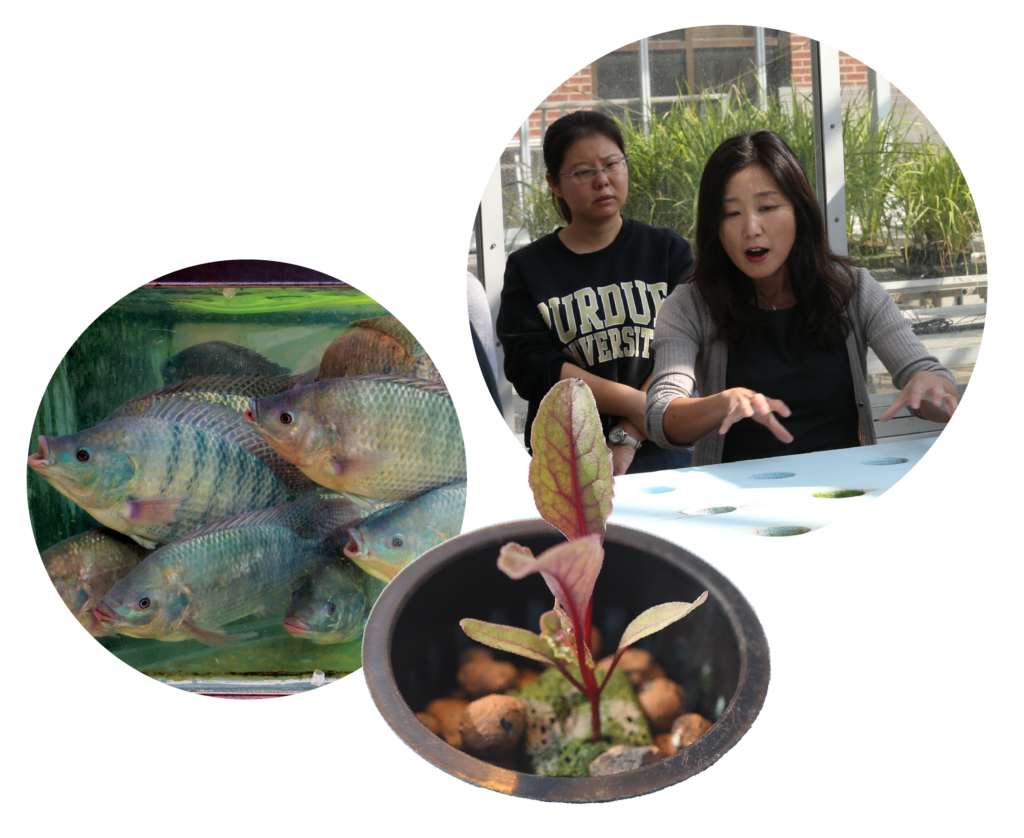AN INSIDE TAKE ON AGRICULTURE

Krishna Nemali, assistant professor of horticulture and landscape architecture, checks hydroponic lettuce in the greenhouse. He also collaborates with schools to set up small indoor growing facilities using hydroponics, which exposes kids to tending plants and making nutritious food choices.
Krishna Nemali, assistant professor of horticulture and landscape architecture and one of the leaders of the department’s controlled environment agriculture initiative, is working up a sweat tending a few small trays of seedlings — primarily lettuce and other green vegetables. Nemali and a team of researchers and Extension specialists are doing more than growing plants here; they’re nurturing an entire industry.
A technology-driven industry
Controlled environment agriculture (CEA) encompasses a number of different technologies and production methods, including hydroponics and indoor agriculture. Generally, CEA refers to the process of growing plants inside a greenhouse, building or other enclosed space where inputs such as temperature, water, light, carbon dioxide and other nutrients are carefully managed and conserved to create optimal growing conditions.
While some of the basic principles of CEA are hundreds of years old — the first record of a greenhouse-like structure in Western history dates to the Roman emperor Tiberius in the first century — the industry is in its relative infancy. Environmental control technologies developed over the past two decades have finally made it economically feasible to produce a much greater variety of food, ornamental and even medicinal crops on a commercially viable scale, Nemali says.
For consumers, CEA ensures ready access to year-round, locally sourced, healthy foods. For producers, CEA provides an opportunity to grow a greater variety of crops while extending the growing season. By generating more revenue from the agricultural sector, CEA could potentially boost the entire economy.
“For example, there are 6.7 million people in Indiana,” Nemali says. “The average consumption of lettuce in the U.S. is 12.5 pounds per person annually. Assuming about half of the people in Indiana eat salad on a regular basis, about 42 million pounds of lettuce is consumed. Indiana growers produced less than a million pounds, meaning that more than 95 percent of the lettuce sold here comes from California or Arizona. If we could grow that lettuce here, it would mean generating an extra $50–60 million for the state.”
The future does seem bright for CEA. Recent industry studies show that the market for vertical farming, where plants are grown indoors in vertical stacks, could grow 24 percent globally by 2024, while the hydroponics market could expand by more than 18 percent in the same time frame.
“We’ve gotten a lot of interest from people who have no previous experience in agriculture,” says Petrus Langenhoven, horticulture and hydroponic crop Extension specialist on Purdue’s CEA team. “A lot of financially savvy people see this as a growth area.”
“It’s amazing to see the kinds of people who come in here to talk to the team for their expertise,” says Alexander Miller, a horticulture and landscape architecture master’s student working in CEA. “It’s everybody from small-scale farmers to big companies.”
Helping producers
Every member of the team works to increase awareness and understanding of CEA. “All of us overlap,” Nemali says. “We all go outside of our comfort zone.”
“We have a lot of small-scale producers showing interest in high tunnels,” Langenhoven says. “If they call their local Extension office, our job is to make sure that the county Extension educator has all the information needed to help the grower, or to refer the contact to us.”
Team members contribute to the department’s Vegetable Crops Hotline and Purdue Greenhouse Newsletter, host meetings and workshops throughout Indiana to work directly with growers, and sponsor demonstrations at special events such as the Greenhouse/Indoor Hydroponics Workshop, the annual Purdue Extension Small Farm Conference and the annual Indiana Horticultural Congress.
The team has several projects in development that could significantly extend its reach. Nemali’s lab is developing a mobile phone app that will enable producers to easily assess plant growth and nitrogen status using photos. His team is also conducting research on improving crop value to increase producer profits, using technologies that increase healthy nutrients and improve food safety in CEA crops.
The team is also developing a video course, expected to launch next year, which will offer technology training for individuals and organizations interested in CEA. “It will enable employees and producers to learn more about the technology on their own time,” Langenhoven says. “It’s such an important part of the business.”
From the simple to the sophisticated
“The best way to understand CEA is through the technology,” Nemali says. “We have operations from the low-tech end to the high-tech end and everything between.”
That technology continuum is especially apparent in the range of greenhouses now available to producers. Modern greenhouses range from simple structures known as “high tunnels” to elaborately engineered buildings utilizing the latest in environmental control and lighting technologies.
High tunnels, also known as “hoop houses,” typically consist of a dome-shaped metal frame covered with a double-layer of polyethylene sheeting. They hold heat from the ground and sunlight and can be as much as 5 to 10 degrees Fahrenheit warmer than the outside.
Even a simple high tunnel could enable growers to start their crops up to a month early and then harvest a month later. The cost of a typical high tunnel can be as low as $7,000, making it favorable for small-scale growers, Nemali says.
Greenhouses can range from simple to sophisticated, with the latest LED lighting and humidity control. Vertical farms, with layers of stacked plants in a controlled environment, are also popping up across Indiana, including Green Sense Farms, headquartered in Portage and selling to Whole Foods, Farm 360 in Indianapolis and Healthy Roots in Rushville.

Jim Bloom, project director of vertical farm Healthy Roots in Rushville, Indiana, gives a tour of the facility to John McCane, executive director of the Rush County Economic and Community Development Corporation.
Conserving resources
Hydroponics, a soilless system where plants are grown using nutrient-rich water, sometimes with a substrate like gravel or lava rocks to support roots, is another familiar form of CEA. Hydroponic systems demonstrate how CEA can be critical in resource conservation.
Crops can’t grow without water. The problem, says Hye-Ji Kim, assistant professor of horticulture and landscape architecture and one of the leaders of the CEA team’s aquaponics and hydroponics efforts, is that today’s high intensity farming operations use too much of an increasingly scarce resource.
“We tend to use a lot of water and fertilizer and energy to grow crops in both field and indoor operations,” she says. “We’ve been happy with the outcome so far because we’ve been able to increase production. However, we are not paying much attention to the waste we are generating through these activities."
The nutrients in runoff from fields and lawns is one of the factors that contribute to environmental issues like algal blooms, including one in Lake Erie that forced Toledo, Ohio, residents to drink bottled water for three days in 2014. CEA systems can produce up to 11 times more yield with 60–90 percent less water than field crops, Kim says.
Another CEA technology is an aquaponics system, which includes both plants and aquatic animals, primarily small fish. The animal waste generated is recycled into nutrient material for the plants, creating an environmentally friendly, highly productive growing environment that can be set up even in resource-deprived areas.
“It is a highly promising technology,” Kim says. “The wastewater from the animals, instead of going down the drain, is used to grow food crops. In an aquaponics system, you can grow at least two cash crops at the same time — basically an entire meal with fish and vegetables.”
The potential aquaponics menu is enticing. Frequent plant crops include arugula, basil, cabbage, lettuce, mustard greens, spinach, peas, strawberries, beets, carrots, onions, radishes, broccoli and cauliflower.

Image group: Hye-Ji Kim, assistant professor of horticulture and landscape architecture, talks with producers at a Purdue Extension hydroponics workshop, but also presents frequently for students, teachers and parents at events like the World Food Prize Institute. Greens and tilapia are common crops in hydroponic and aquaponic systems. Fish by Docter_k/Shutterstock.com.
“We are still working to identify critical control points of the system and varieties of these different types of crops that would do best in an aquaponic environment,” Kim says, “but the potential is very exciting.”
Purdue’s controlled environment agriculture team is also seeking to expand the range of aquatic animal species that could be raised profitably and productively in an aquaponics system, including trout, catfish and bass. Tilapia is the most popular fish grown in aquaponics in the U.S. because of its adaptability to a wide range of water environments, but its relatively low value makes aquaponics less profitable.
An efficient aquaponic system could use up to 98 percent less water than a comparable field operation, Kim says. “The future of food is a really important topic these days. We have to be responsible about how we approach that future.”
Unanswered questions
While hydroponics and aquaponics can potentially create new markets and food sources, Kim notes the challenges of these technologies as well. Both systems require careful, daily management, and producers need training to develop the necessary skills and expertise, she says. In addition, the energy costs of these systems can be demanding, and start-up costs are high. She believes these obstacles can be overcome through continued research and technological development.
Nemali isn’t shy about sharing his enthusiasm for CEA, but he tempers his expectations with a healthy appreciation for market realities. Plenty of questions remain unanswered, such as which crop varieties grow best in controlled environments, which offer the best return on investment for producers and what consumers are willing to pay for.
“We ask these questions all the time,” Nemali says. “That’s what will continue to drive our work.”
Purdue Agriculture, 615 Mitch Daniels Blvd, West Lafayette, IN 47907-2053 USA, (765) 494-8392
© 2024 The Trustees of Purdue University | An Equal Access/Equal Opportunity University | USDA non-discrimination statement | Integrity Statement | Copyright Complaints | Maintained by Agricultural Communications
Trouble with this page? Disability-related accessibility issue? Please contact us at ag-web-team@purdue.edu so we can help.

